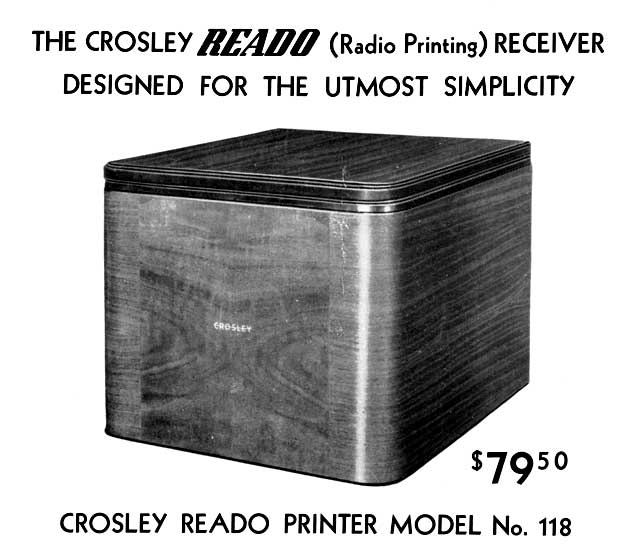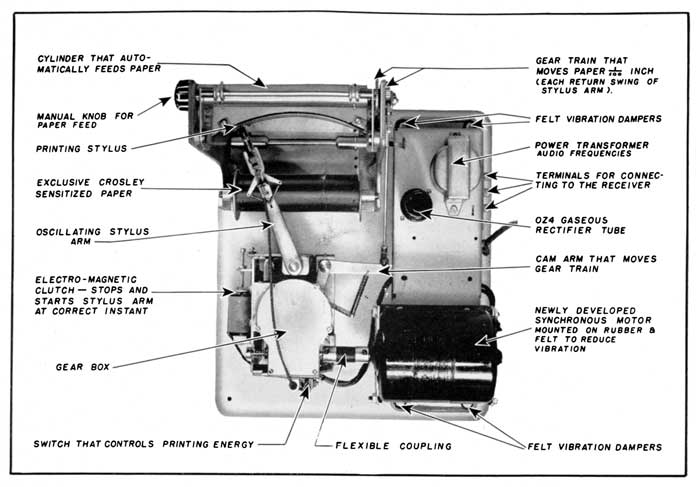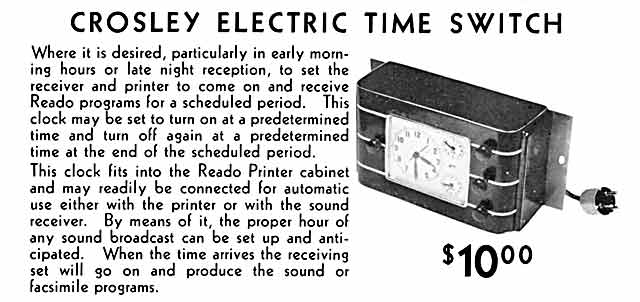The Crosley Reado Printer Converts Radio Waves Into Text And Pictures On White Paper
Updated 20 Nov. 2005
Crosley Reado (Radio Printing) Transmitter
Powel Crosley started producing what was one of the first low cost radio facsimile receiver for the home in the late 30s. Broadcasting news and weather over the WLW air waves when it went off the air around 12:30 at night. In January, 1939, Crosley announced it had manufactured 500 sets and had set up a factory to turn out 1,000 per day.
13 stations were equipped to transmit pictures under the Finch system under an experimental program early in the production of the Reado. Only 8 are known to have continued the service. The first 3 stations on the air were broadcasting in October, 1937, and Crosley's WLW and its Mutual Network partners, WOR and WGN, were experimenting with station-to-station radio FAX transmissions a few months later, and were on the air not long after. WLW continued radio FAX broadcasts during the early part of WWII, and Powel read his Reado strip for the latest news every morning.
The range of transmission was not as great as the normal radio broadcasting because facsimile is more subject to static and other forms of interference. Under the Crosley Finch system of transmission and reception the receiving set synchronizes itself on the 60 cycle, 110 volt transmission and receiver current.
Crosley was licensed under the Finch patents to manufacture receiving equipment designed to receive images transmitted by the Finch system.
 |
Model 118 and 119 were manufactured and a kit was marketed for Hams to build it them self
.
 |
 |
The broadcasting station must be equipped with a device for visualizing the picture just as a broadcasting station is equipped with a microphone for hearing a sound program. This visualizing device consists of an electric eye which moves back and forth rapidly across the paper, scanning a line at a time and translating the line by the electric eye into electrical dots which are then transmitted by the broadcasting station in exactly the same manner-as it broadcasts regular programs. Crosley uses the Finch system of facsimile, developed by V. G. H. Finch in his laboratory over a period of many years.
Transmission of pictures on the normal broadcasting band 530 kHz to 1570 kHz was limited to hours between 12 PM and 6 AM when the station wasn't normally on the air. Some transmitters were licensed to transmit facsimile from high frequency stations between 25 mHz and 47 mHz that were available for daylight operation.
The Reado operated under the Finch system but with many features developed in the Crosley laboratories.
 |
Examination of the picture above shows the component parts of the printer. A roll of coated paper feeds through the printer one line at a time. This movement is synchronizes with the transmitter. A stylus moves back and forth across the paper emitting electrical impulses synchronized with each dot as scanned and transmitted by the broadcasting station. Each dot penetrates the white coating on the paper, removing the white allowing the black paper to show through.
The result is printing in black with a white background similar to black printing or pictures on white paper. The paper was dry, and inexpensive. As the paper feeds through the printer it comes out in a long strip 4 11/16 inches wide with each hour of broadcasting produces approximately three feet of paper. Reproduction of photographs were similar to those appearing in the daily newspapers. The printed material was permanent, examples that exist today show only yellowing of the paper.
 |
The Crosley Reado printer could be used with practically any radio set that delivers 5 watts of power or more. It was attacked in place of the loudspeaker with a switch. When used with an ordinary broadcasting receiver constant attention is required in order to maintain proper printing level. Crosley made available a receiving set incorporating several automatic features for the production of better pictures without constant supervision.
The art of transmitting pictures and other printed material by radio will advance. Nothing shall hamper its growth. Pictures of world events, cartoons, comic strips, news flashes weather maps, market reports, everything of a visual nature will soon be coming over the' air. It is not anticipated that facsimile will directly compete with the newspapers It will unquestionably be and continue to be a source of flash news rather than detailed mass printed material which can only be supplied by the newspapers and periodicals. Facsimile does not directly compete with sound broadcasting. On a separate channel It will unquestionably be available as an augmenting service, providing a visual record of material other than music and sound being produced for your perusal whether you are present or absent.
Facsimile is an entirely separate art from sound broadcasting just as It Is entirely separate from television which may or may riot be generally available within the next few years. Facsimile can be broadcast by any broadcasting station by the substitution of a scanning or pick-up device in place of a microphone. Television requires entirely different setup and technique.
It seems unlikely that television will be available from any station in the near future without the investment of at least one hundred thousand dollars per station for studio and equipment.
A wealth of material is available for facsimile at small cost. Material can be printed on an ordinary typewriter and broadcast interspersed with Photographs which are generally available. Television will require production cost comparable to that of Hollywood. As television receivers will be quite costly when it does come out of the laboratory, the number of television receiving sets in use will be comparatively small, offering to the advertiser suck a small audience that it will be a long time before picture production costs can be absorbed.
Eventually we believe that every home will be equipped to receive sound, facsimile, and television.
The problems involved in facsimile broadcasting are simple. Even to the smallest broadcasting station facsimile is available. Present estimates indicate that in television with a primary cost of about one hundred thousand dollars to a broadcasting station that the production cost of suitable pictures would be at least a million dollars a year for only one hour of production per day.
 |

Powel Crosley firmly believed that the radio facsimile receiver was the future
The art of transmitting pictures and other printed material by radio will advance. Nothing shall hamper its growth. Pictures of world events, cartoons, comic strips, news flashes weather maps, market reports, everything of a visual nature will soon be coming over the' air.¬ It is not anticipated that facsimile will directly compete with the newspapers It will unquestionably be and continue to be a source of flash news rather than detailed mass printed material which can only be supplied by the newspapers and periodicals. Facsimile does not directly compete with sound broadcasting. On a separate channel¬ It will unquestionably be available as an augmenting service, providing a visual record of material other than music and sound being produced for your perusal whether you are present or absent.
Facsimile is an entirely separate art from sound broadcasting just as It Is entirely separate from television which may or may riot be generally available within the next few years.¬ Facsimile can be broadcast by any broadcasting station by the substitution of a scanning or pick-up device in place of a microphone. Television requires entirely different setup and technique.
It seems unlikely that television will be available from any station in the near future without the investment of at least one hundred thousand dollars per station for studio and equipment.
A wealth of material is available for facsimile at small cost. Material can be printed on an ordinary typewriter and broadcast interspersed with Photographs which are generally available. Television will require production cost comparable to that of Hollywood. As television receivers will be quite costly when it does come out of the laboratory, the number of television receiving sets in use will be comparatively small, offering to the advertiser suck a small audience that it will be a long time before picture production costs can be absorbed.
Eventually we believe that every home will be equipped to receive sound, facsimile, and television.
The problems involved in facsimile broadcasting are simple. Even to the smallest broadcasting station facsimile is available. Present estimates indicate that in television with a primary cost of about one hundred thousand dollars to a broadcasting station that the production cost of suitable pictures would be at least a million dollars a year for only one hour of production per day.
From the Reado brochure 1940
|
|
|
|







